The Catalonian
Branch of the MGS
Past Events
January 2016
Branch meeting
On Saturday January 16th a meeting was convened at the Blanes botanical garden, Marimurtra, with the principal objective of debating and agreeing the immediate future of the Catalonia Branch.
A total of 15 persons attended, of whom 3 are members of the MGS.
Before the main business of the meeting, Brian Constable gave a splendid presentation of his recent visit to Namibia with a most interesting commentary on both plants and animals which he had observed. This was most warmly received.
The meeting then turned to the future of the group as an MGS branch and the desirability or otherwise of maintaining the existing links with the MGS.
Jordi Fabregas and Mercè Trias, who have coordinated activities in recent years, confirmed their decision to step down, and Sergi Massanés and Lluis Mimó confirmed their willingness to coordinate activities for the immediate future. Their decision was accepted with gratitude by those present and it was further agreed:
- That the relationship of the group with the MGS would be maintained so that it would continue to be the Catalonia Branch of the Society.
- That John Copestake would undertake to communicate with the MGS and report on activities.
- That Brian Constable would continue to advise members of proposed activities.
- That it would be the responsibility of members proposing a given activity both to organise this activity and to prepare a report after it had taken place.
A number of proposals for future activities were made by members present, the first a visit to a private garden in S'Agaro in late March or early April. Dates and details of this visit, to be organised by Mercè Trias, will be confirmed shortly.
At the close of the meeting and with the principal objectives satisfactorily achieved, most members adjourned for lunch at a local restaurant where, over an excellent meal, further discussion took place.
September 2015
Lectures on Caudiciforms and Succulents in Marimurtra
The day began with a welcome by Ramon Maria Masalles, botanist and member of the Carl Faust Foundation.
In the first lecture Peter Fraga, botanist and a “master gardener”, discussed the false apparent suitability of succulents and cacti for garden conditions in the Mediterranean coastal areas.
The next lecture, by Xavier Duch, member of the ASAC (Friends of the Cactus and Succulents), gave an overview of the main species from his collection and showed pictures of these plants in their habitat. He explained how some species could be grown successfully as pot plants when growing substrates, watering and temperature are controlled.

Andreu del Campo, also a member of the ASAC, talked about his experience in the cultivation of Adenium spp. He described the characteristics of each species – flower colour, thickened roots etc. – to be taken into account when choosing the desired variety. Finally, he showed superb hybrids obtained in recent years.
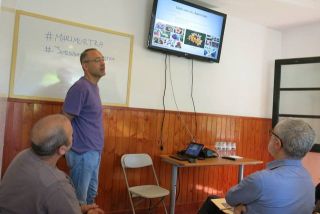
The last lecture was given by Ivan Soto, who is responsible for Marimurtra’s Cycadales collection. He highlighted the importance of the cycad donation made by Jordi Grau to the garden; some of the specimens are already thirty years old. He also talked about the new area to host these cycads and the reproduction programme carried out in the Marimurtra nursery. He lectured us on the most important aspects of their cultivation, as well as giving us several details regarding their propagation.
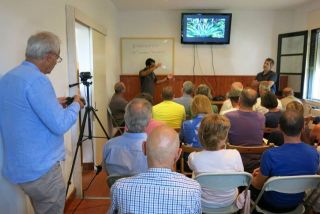
The event finished with a tribute to Antonio Aguilar Rubio, a cactus and succulent nurseryman from Blanes. Josep M. Camarassa, botanist and member of the Carl Faust Foundation, gave him the Marimurtra Diploma to pay homage to his professional life dedicated to the cultivation of these plants.
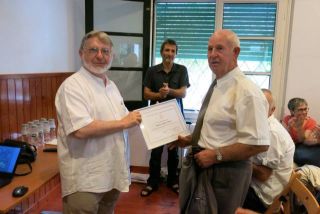
Lunch took place in a corner of the garden, surrounded by sea views and amidst an exhibition of Caudiciform plants, provided by the Garden Centre of Floranova from Malgrat de Mar.
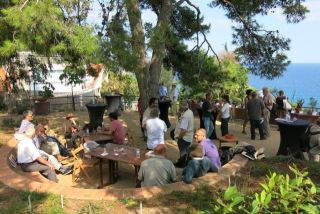
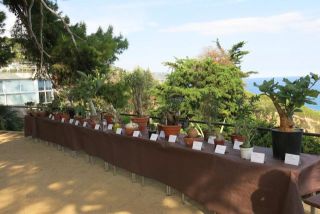
In the afternoon, Ivan Soto and Xavier Argimón, taxonomist of the garden, showed us the Cycadales collection and some amazing specimens of Beaucarnea. Finally, Josep M. Riba, consultant phytopathologist, and Ventura Torroella, head of pest control in the garden, explained how they have dealt with the agave weevil (Scyphophorus acupunctatus) during the last year.
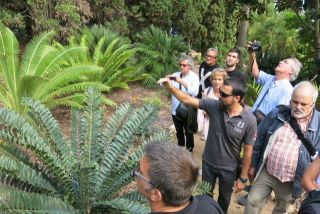
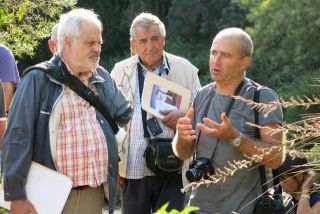
Text by Jordi Fàbregas, photos by by Josep Borrell (from Marimurtra Botanic Garden)
July 2015
Visit to Carex Nursery - Cornellà de Terri
This visit began with a warm welcome to the nursery’s office by Joan Parera and his son and daughter. He gave us a brief introduction regarding the nursery’s origins: growing reforestation plants and growing plants for gardens that are not watered.
Joan explained which plants are considered mediterranean and which are not. He emphasised the fact that some Mediterranean species, such as Lonicera implexa, find it hard to grow in our gardens, while some others that are not from this region, such as Tillandsia or Hydrangea, usually grow perfectly when given the proper location.

Some of the novelty species were Celtis biondii, Celtis bungeana, Celtis julianae, Celtis laevigata, Cupressus dupreziana var. atlantica, Phillyrea latifolia (tree form), Pinus halepensis (syn. P. ceciliae) and Pistacia chinensis.
Joan told us an interesting story about the Tamarix aphylla: he took a cutting from a Moroccan oasis, where traditionally guests at wedding parties are given branches to be planted in their vegetable gardens. The first specimens grown at his nursery were uprooted by strong floods. Some of them were recovered and planted again in a corner of the nursery. An employee, not recognising them, threw all these plants on the rubbish pile. Eventually, after searching through all the rubbish, they were found and replanted.

Joan Parera’s own comments about his garden:
- “This garden reminds us of symbols and memories, whereas for a visitor it doesn’t represent anything: there’s a Pistacia lentiscus specimen which comes from one of the very first seeds planted at the nursery, there’s also an Acer species from the period when Antonia and I were living in Mas d’Arcay...”
- “We have given this garden its shape taking into account our tastes: it’s rich in species because of my interest in botany; we love aromatic species, so there are plenty of them; due to the fact that I like succulent plants, we’ve got a collection, although they’re put in a corner because my family can’t stand thorns...”
- “I’m interested in details rather than structure, so I haven’t worried about making paths; I’ve maintained the ones made by horses and donkeys.”
We recommend a virtual visit to Joan’s web page.

Practical exercise to determine drought codes
This exercise came after some remarks from Pat Mills regarding the current classifications on plants’ resistance to dryness:
Mills’ coefficient of Dry–Heat Resistance. You can read the two articles on heat resistance by Patrick Mills, published in 2005 and 2006, if you click here.
Filippi’s scale of drought resistance: a scale of 1-6, according to the number of months of hydric deficit that plants can withstand. A plant’s place on the scale is established by observation.

In the afternoon we visited the garden observing plants and taking notes about the codes. We usually agreed on these codes. Finally we discussed the pros and cons of both systems.
We concluded that physiological resistance to summer heat and the deterioration in a plant’s ornamental quality must be described jointly because the ornamental value of a plant is a key element in a garden that receives no watering.
Joan Parera proposed an easy and clear system including both, which could be discussed and improved.
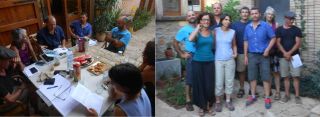

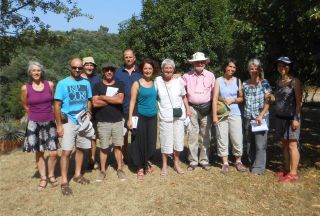
Text and photos by Jordi Fàbregas
June 2015
Plant workshop, garden sculpture and clay flowerpots
Carme Bosch’s workshop
We began the day in Carme Bosch’s workshop. This craftswoman had prepared a workshop on aromatic medicinal plants. She gave us a warm welcome with a tasty herbal infusion. We learnt about uncommon plants such as Agastache rupestris and A. mexicana. The genus Agastache has species from North America and Asia and a lot of them are used as therapeutic and edible plants. We continued with Tagetes lemmonii and Perovskia atriplicifolia. Sage is already a well-known plant; we focused on Salvi sclarea, S. leucantha and S. leucophylla. We had the chance to discuss their uses, compare, taste and smell them. Two species from South Africa with many medicinal uses were Eriocephalus africanus and Pelargonium odoratissimum. Finally some plants which are much more common and which are present in the Mediterranean region: Helichrysum stoechas, H. italicum and Myrtus communis.

In the last part of the workshop we made a skin cream using shea butter, almond and argan oil as the basis. Some leaves from plants suitable for the skin (Eriocephalus, Helichrysum, Myrtus and Pelargonium) were added to the main mixture. We also added some drops of the essential oil of Salvia sclarea. Each participant made his/her own nutritive cream.
We were informed about the importance of plant knowledge and in which proportions the ingredients should be used.

Later we prepared a tea with Perovskia and Eriocephalus, but because we did not know the correct proportions of these plants to use it was too bitter!
Afra Lòpez: stone and ceramic workshop
We had lunch in the forest in front of the workshop of the artist Afra López and afterwards we enjoyed a visit to her garden with some of her stone and ceramic creations. Afra explained in detail some of the techniques she uses to create her original works of art. She told us that the most important feature of her work is the search for contrast with the light. Without light her sculptures would make no sense. Nature inspires her, for example the spirals of snailshells and the shapes of leaves. Finally, we had a demonstration on how to use the potter’s wheel.

The picnic in Afra’s forest was really enjoyable


Bonadona Terrissers, Quart: clay flowerpots
Our last visit was to Eloi Bonadona’s workshop. He showed us the process of making clay flowerpots. This process begins with the choice of clay, he then showed us how it must be prepared to make it suitable for turning; drying and firing are the last stages.

Eloi showed us three kinds of potter’s wheel, used depending on the size and shape of the piece. At the end, we saw a collection of old clay pieces from Catalonia and the rest of the Iberian Peninsula.

Text and photos by Mercè Trias, Jordi Fabregas and Esther Peñarrubia
June 2015
Re-verdir la ciutat
On June 7th we participated in the event “Re-verdir la ciutat”, organized by the Association Amics del Jardí Botànic. It took place in an unbeatable location, the patio and lawn surrounding the country house of the historic botanical garden of Barcelona. It was the first meeting for Catalan Societies related to gardens, botany and horticulture, such as: “Jardins i Jardiners de l’ICEA”, “Plataforma veïnal El jardí del silenci”, “Eixverd” or “Gardens from Spain”. We are so thankful to this initiative because it allowed us to present our society. During the event we enjoyed a great jazz concert by “The Blind Voice” and, to finish, the book “La invención del reino vegetal” from Aina Erice was presented.


Text and photos by Mercè Trias, Jordi Fabregas and Esther Peñarrubia
May 2015
Excursion to the Montserrat mountain
On Saturday 16th May, Sergi Massanès, collaborator of the Catalan branch of the MGS, guided us on an excursion to discover the flora and landscapes of this unique and iconic mountain of Catalonia. The Montserrat massif consists of hundreds of needles and unique forms of conglomerate rock walls. The erosion from water and wind on this type of limestone matrix over millions of years has led to this unique mountain world.
The excursion took place around the northern and southern slopes of the mountain, making a circular route starting in Santa Cecilia, following the Arrels path to Sant Benet, St. Joan, the Monastery and Degotalls. The day was radiant and the company equally splendid.

MGS Members in front of Cavall Bernat
The northern side of the mountain of Montserrat is surrounded by great walls and needles over 250 m tall. Cavall Bernat is provably the best-known spire.
The oaks develop very well thanks to the more humid conditions and shelter that these walls offer. Apart from the oak, Quercus ilex subsp. ilex, we can find many characteristic species of more humid climates such as Acer opalus, Sorbus aria, Pinus nigra, Sorbus torminalis, Ilexaquifolium, Tilia cordata, Buxus sempervirens and a rich understorey of shrubs, vines and herbs such as Amelanchierovalis, Viburnum tinus, Coronilla emerus, Bupleurum fruticosum, Ruscusaculeatus, Smilax aspera, Aquilegia vulgaris, Polypodium vulgare, Polygonatum odoratum, Saponaria ocymoides, Atropa belladonna, among others.

El Mariner, les Magdalenes i la Gorra Frígia
The southern slope of the mountain is much drier and the landscape is dominated by hundreds of needles with a variety of forms such as Mummy, The Elephant, the Pregnant Woman, the Bishop's Belly, Magdalena. In this area we can find the endemic Ramonda myconi and Saxifraga fragilis. The dominant tree is still Quercus ilex subsp. ilex, but there is a greater presence of Pinus halepensis and shrubs and bushes, such as Genista hispanica (syn. G. hispanica subsp. hispanica), Stipa barbata, Genista scorpius (syn. G. scorpius subsp. scorpius), Dorycniumpentaphyllum (syn. D. pentaphyllum subsp. pentaphyllum), Dorycnium hirsutu, Gladiolus communis, Globularia alypum, Santolina chamaecyparissus, Helichrysum stoechas, Rosmarinus officinalis, Teucrium aureum (syn. T. polium subsp. aureum), Thymus vulgaris, Saturejamontana.
Visiting the unique landscape of Montserrat is a must for botany and landscape lovers. If possible, go
on a weekday or a Saturday, avoiding crowded areas like the Monastery and Can Massana. The GR (Great Trail) that goes through the North face and the Arrel path is perhaps the most recommended itinerary for lovers of tranquility and plants.

Sagrada Família sketch by Antoni Gaudí and Montserrat needles
November 2012
Barcelona Garden Tour
Members were very fortunate to be guided through the gardens by MGS member Xavier Argimon (author, designer and botanist). As Xavier was responsible for cataloguing the plants in the gardens, it was a very in-depth tour of three gardens in Barcelona – Jardins de la Tamarita, Jardines del Palau de les Heures, and Jardines Rodrigo Caro.
Jardins de la Tamarita
The gardens have many fine features. On entering them, we were greeted by a semicircular pond with little fountains, water plants and two sleepy, terracotta lions on either side. Behind them is filigree, a semicircular wire fence completely covered by a similarly wire-like climber with tiny green leaves, called maidenhair vine.
All around La Tamarita we found quiet corners in the shade of hundred-year-old trees, surrounded by plant borders with a little entrance that invites us in to sit a while on a bench. Cool places, like the Font de les Granotes, at one end of the garden, a piece of grass to sit for a moment, or places where we can enjoy the scent of flowers.
There are stone, marble and ceramic figures which have been turned into fountains, steps and paving made from slabs of natural rock and, all around the garden, the sober elegance of ornamental terracotta plant pots, with their geraniums and ferns.

The main way through the garden is a walk watched over by allegorical statues from America, Africa, Asia and Europe. It is reached by paths bordered by dense myrtle neatly cut into geometric patterns, growing under the shade of tall plane trees.
At the centre of La Tamarita, in the Plaça dels Quatre Continents, the main feature is a fountain. At the top, a waterfall in the form of a grotto made from pumice stone and shells, like those many patios used to have, closes the classic part of the garden.
Next to the house, surrounded by trees and beautifully cut plant borders, there is a very quiet area with grass and benches, descending some semicircular steps; it is worth visiting one of the most charming spots in La Tamarita: the gardenia garden, where the water flowing from a fountain to a little pond in the middle, from where it spreads via small pipes, reminds us of Arab gardens.
The Tamarita Gardens are eclectic. Consequently, there are landscaped areas with a classical appearance and other more natural, unplanned areas, behind the house.
The wildest part of the garden is reached via a large meadow and slopes towards the stream, Frare Blanc. It is shady, cool, with lots of thick undergrowth. You enter via a pergola decorated with climbing plants.
A path lets you walk along the bed of the former stream. Because it is not flat, this part seems much more natural.
In the Tamarita Gardens there are truly exceptional examples trees and shrubs. Climbing, to the right of the central walk through the gardens, at the start of the meadow and behind the sculpture representing Africa, you come across an oak tree, which is more than a hundred years old.

Palau de les Heures Gardens
Up in the Montbau neighbourhood, at the foot of the Collserola hills, stands one of the most singular buildings in Barcelona: the Palau de les Heures, built in the late 19th century. It overlooks gardens whose merit lies both in their beauty and in the richness of the vegetation, including an outstanding collection of trees.
If the house, the Palau de les Heures - with its four round towers crowned by conical points, in the style of French châteaux - is impressive, the view of the gardens from the terrace at the front of the building is frankly majestic.
The whole is of a great harmony, with broad stairs on either side of the 'palace' running down the hillside to successive sections of the gardens. Long ramps between the flights of stairs facilitate access for people with disabilities.~
Boston ivy and rose bushes climbing the walls of the terraces adorn the paths, punctuated here and there with large terracotta pots blooming with fragrant geranium with its small, delicate flower.
From the bottom of the gardens, the view is perhaps even more striking than from above: the manor house looms high over the spectacularly landscaped terraces, elegant and inviting.
The south-facing gardens are laid out on terraces, the highest of which is occupied by the house and a smaller garden. The middle and the lowest - which is the largest - are both of greater notes in terms of landscaping.
Both are laid out geometrically, with parterres, paths and pools in contrast to the vertical counterpoint of towering palms and the leafiness of, among other trees, large magnolias and enormous horse chestnuts.
All around there are benches for sitting in the shade of the trees or in the sun, especially on the top terrace.
Due to their height, what stand out most in the gardens are the palm trees, especially the Washingtonia robusta with its broad fan-shaped leaves, and the Canary Island palm, topped with majestic crowns. On their own, these palms give the gardens a distinctive character.
Other noble members of the tree family include magnolias, with their spectacular summer flowers, large acacias, bitter orange, olive trees, towering cedars, pines, holm oak and cypresses.
Small round parterres boast roses, while the larger ones - eight in both the lower terraces - contain big trees and palms surrounded by exquisitely trimmed and sculpted hedges.
September 2012
Visit to Soljardi Fruit Nursery
Jordi Bronsom, one of the owners of Soljardi, gave members a very informative tour around their extensive vivero. The nursery grows and cultivates an extensive catalogue of unusual fruit trees, nut trees and fruit bushes. Jordi has extensive knowledge and experience in growing and treating fruit trees – which was demonstrated in an informative presentation on pests and diseases. For further information or to order plants, contact Jordi at their website or by email.
June 2012
Morning - Mas Bover, IRTA
The visit to Mas Bover was led by Mr. Ignasi Batlle, responsible for the IRTA's subprogramme ‘Olive Production, Oil Processing & Nut Trees’. After a brief introduction in the office, we took a walk around the collections of pistachio, olive, almond and carob trees.
Afternoon - Visit to Reus. Jordi Ingles, a member of the MGS and responsible for the maintenance of various parks in Reus, took us around different green zones of the city.
May 2012
Visit to Cervantes Rose Garden - Barcelona
Members enjoyed a truly wonderful and informative day at the Cervantes Rose Garden in Barcelona. It was hosted by Anne Neuve-Eglise, who was instrumental in the design and restoration of the Rose Garden that started in 1999 and lasted 5 years. We all sat under a shady tree while Anne explained how the garden had been designed, showing us copies of the original design drawings. Anne explained the classification of the roses in the garden (copy is attached) and took us on a guided tour of the rose garden – along a botanical pathway
There are around ten thousand rose bushes of two thousand different species and varieties - from Asia, the Middle East, Europe and America.
There is a big semicircular pergola full of 233 different varieties of climbing roses. There is shade here, with benches to sit and contemplate not only the roses, but also the magnificent views of Barcelona.
The rose beds are orderly and surrounded by grass. Little paths with arches covered in roses invite you to enter. Here there are well cared for and orderly gravel paths, but you can also walk on the grass, to get even closer to the roses.
The entrance by the Avinguda Diagonal is full of roses planted for their wonderful scent. There are 235 varieties, and you don't have to be up close to smell the perfume, the whole air is full of it.
The scent accompanies you for a while as you move on and come to a sculpture of a woman and six olive trees admiring the roses. Nearby, the shade of the lime trees invites you to join them and rest for a while to admire the view.
As a rose enthusiast I have never seen such a wonderful and extensive collection of roses by country, by species and by grower. We ended the day with a picnic lunch: thanks so much, Anne, for making the visit so memorable – we will return for sure.
May 2012
Garden Visits to Torre Ronsat and Mas Pica
The day started at Torre Ronsat, which has been beautifully restored by Shaunagh and Crispin Latymer. Crispin explained the different stages of the restoration project and then took us for a guided tour through their beautiful, extensive gardens, which included an olive grove and wildflower garden. We were able to see some wild orchids, including Serapias lingua.

o visit Mas Pica, which has been elegantly restored by Giles Money-Coutts. Giles explained how he had restored the masia and how he had designed the garden to be mainly drought-tolerant. The garden consisted of a number of rock-walled terraces, which had been made from an attractive rock from within the garden. It will be great to go back to see the garden when it is established, as it certainly has been well planned.
It was a very interesting and enjoyable day thanks to Shaunagh, Crispin and Giles. The day also raised 57 euro for the Rwanda Cricket Stadium Charity – thanks to the members’ contributions.

May 2012
Wild flower Walk in Montseny
Christopher Witty took us on a truly remarkable guided walk of the area of Montseny. This year proved to be one of the best years ever for wild flowers – the group saw many different wild flowers, including many different and unusual orchids.
Chris’s knowledge of wild flowers gained from his extensive travels is so interesting – thanks again Chris. We hope to repeat it next year if Chris is up for it. Although only 8 members attended the event, it was an exceptional day. Chris recommends the following two wild flower books:
- Les Orquidies del Montseny by Meritxell Maymo I Reverter – Published by the Museu de Granollers – Christopher can help with copies if you cannot find this book
- Collins’ The Wild Flowers of Britain and Northern Europe – Available from Amazon
April 2012
Guided tour of the show gardens at Cultidelta in Amposta
This visit encompassed 125-150 different mediterranean plant species. It was an extremely educational visit which ended with a short trip to the Els UIlals de Baltassar wetland, formed by freshwater surges that create small natural lagoons with specific vegetation consisting of Cladium mariscoides and Nymphaea alba.


After lunch we visited Raimón Corberó’s experimental garden with its many different trees and plants together with an impressive wisteria. We also visited the garden of Raimón’s mother, who has created an amazing English garden in the hills of Catalonia, where she grows peonies and orchids, among other plants. We sampled some gourmet pizza and wine made from Raimón’s own vines. What a lovely end to a great day.


March 2012
Visit to Can Torres and Talk on Organic Gardening, Companion Gardening and the Worldwide Organic Movement
At our visit to Can Torres, twenty-eight members enjoyed a very informative presentation on the worldwide organic movement given by David Pierson, and an enlightening talk on organic and companion planting by Karen. Afterwards two groups toured around Karen and David’s beautiful garden perched high on top of the Gavarras Mountains overlooking Girona.
They have designed both their vegetable and flower gardens with precision and incorporating their main objectives: ‘organic, recycle, sustainability’. Thanks so much, Karen and David.


February 2012
Mar-i-Murtra Botanical Gardens – Presentation on Soils of Catalonia and Plant Health
Peter Steadman gave an excellent presentation on the soils of Catalonia and plant health – it was a great opportunity for members to understand how important our soil is when planting and choosing the right plant for the right place.
After the presentation we toured the gardens, and Jordi Fabregas, who previously worked at Mar-i-Murtra, gave us lots of information on the various plants along the way. It was a lovely day, which ended with a lovely lunch at Restaurant Melangies in Blanes.
December 2012
Garden Tour and Christmas Lunch at Pacha Mama - Calonge
The group of sixteen members toured around the garden, which gave me some good ideas. The garden is terraced over five levels and has a combination of different planting designs. After the tour we had a very productive planning session where we agreed on an agenda for 2012. We had a wonderful gourmet Christmas lunch with all types of different dishes contributed by the attendees, and of course some libations - a good end to a good year.
October 2011
Talk by Dick Handscombe at Melissa Levy’s garden
Another lovely day where 36 members and friends of the MGS started the day by sipping coffee and walking around Melissa’s beautiful garden. This was followed by a very interesting talk by Dick Handscombe, who explained the many concepts of Mediterranean gardening in an ecological manner. Dick brought along some free organic products to try, together with some medicinal plants. Members were also given the opportunity to purchase any or all of his six Mediterranean gardening books at a discount price.
During the rest of the day Dick mingled with members and answered their many gardening questions
The plant and seed stand was very popular, and we thank everyone for contributing so many plants and seeds. This was a success as we raised 165 euros for the local Chaplaincy of St. Stephen’s. What a great way for the MGS to contribute to the local community.
The picnic lunch was a huge success with many contributions of a variety of different and tasty foods.
September 2011
Visit to gardens of Xavier Corberó
What a wonderful day – 22 members had the opportunity to not only visit the private gardens of the famous Catalan Sculptor Xavier Corberó, but also to see his amazing house and collection of sculptures. Miru gave us a tour of the garden, which has some wonderful trees, patios, and nooks and crannies to keep us all interested.
Xavier guided us through many larger than life stone sculptures that stand in one of his gardens alongside a flowing pool. You can see one of Xavier’s sculptures in the entrance to the Cap Roig Gardens. Afterwards we had a lovely picnic in the Garden of Human Rights, which is in the grounds of the old Philips Factory in Barcelona.
June 2011
Visit to Sala Graupera Nursery
It was a glorious day when 20 members visited this wonderful nursery. Sala Graupera has 50 years of experience in cultivating plants from all the mediterranean zones – particularly from Australia and South American. The owner, Lluís, gave us a tour of their extensive commercial propagation area, taking us through the various stages of cultivation - a true education. His wealth of knowledge, enthusiasm and humour enthralled us all.
The nursery was in full bloom with salvias of every colour, together with an extensive collection of grevilleas and grasses. All plants are exclusively labelled for Mediterranean growing conditions. We also viewed their plant trial area which had some very interesting grasses and lawn alternatives.
Although Sala Graupera does not sell directly to the public, they will take orders from MGS members – you would need to send them an email stating what you would like to purchase and then pick it up. They have a very colourful catalogue in English, Catalan and Spanish. I am definitely going down with my trailer in October to fill it up with some unusual plants. More information here.
May 2011
Guided wild flower walk by Christopher Witty
Christopher took us on a truly remarkable guided walk of the area of Montseny. This year proved to be one of the best years ever for wild flowers – the group saw many different wildflowers including an orchid.
Chris’s knowledge of wild flowers gained from his extensive travels is so interesting – thanks again, Chris. We hope to repeat this event next year if Chris is up for it. Although only 14 members attended it was an exceptional day, so please don’t think that if only a few people attend our events it’s not worth attending.
May 2011
Talk on mediterranean plants by John Fielding
We joined the UK MGS Branch for an interesting talk and a wonderful photographic experience by John Fielding. John, a very knowledgeable plantsman, took us through a photographic tour of Greece, Cyprus, Israel, France, North Africa and Spain, and we didn’t even have to leave our seats. It was also pleasant to chat over dinner with fellow MGS members from the UK. Thanks, John!
April 2011
Visit to Sérignan-du-Comtat Rare Plant Fair - France
Brian Constable arranged a great day at the nursery of Olivier Filippi, where the guru gave members of the Catalonia and Languedoc Branches a very informative tour of his garden, nursery and trials area. The following day everybody enjoyed a visit to Sérignan-du-Comtat Rare Plant Fair.
We are hoping that next time there will be more interest from members; however, if there is anywhere in particular you would like to visit in France or Spain, please let me know.
April 2011
Guided tour of Barcelona Botanical Gardens
It was a glorious day of sunshine for our visit to the Botanical Gardens, attended by 19 members. We had an excellent guide who gave the tour in English and took us through South Africa, Australia, and other mediterranean plant growing countries. She gave us in-depth information about many of the plants, which was very enlightening. We had a picnic lunch in the grounds outside and then returned to continue touring around the countries we had missed. We were also fortunate to have Evarist March from Natural walks in our group, who explained more about many of the plants. Thanks, Evarist.
March 2011
MGS trip to Israel – by our roaming reporter Brian Constable
In March, Alisdair Aird through the auspices of the MGS and the Cyclamen Society organized a week´s trip to Israel. The guide was MGS member Oron Peri, who lives in Israel.
The first day was spent in Jerusalem, when we saw the city from various viewpoints, visited the Market, the Wailing Wall and the Church of the Holy Sepulchre. Twice we tried to visit the Al-Aqsa Mosque and couldn´t enter.
As we left Jerusalem the next day, the scenery rapidly changed to “desert-like” as we drove down towards the Dead Sea. No irrigation here.
The visit to Kibbutz Ein Gedi with its botanical garden was wonderful, full of beautiful flowers and trees, mainly from Africa and other tropical regions. These included Pseudobombax ellipticum.
Near the Sea of Galilee and on to the Golan Heights we stopped several times to see wild flowers including Lupinus pilosus, Ferrula communis, Cyclamen persicum, Fritillaria persica, Iris atrofusca and many others.
The “no-expense-spared” (reputedly costing 270 million US$) spectacular Baha´i Gardens in Haifa were not to everybody´s taste, but there were lots of very pleasant water features. Thank goodness we started at the top, as there were about a thousand vertiginous steps to go down.
The last day was spent visiting the Poleg Stream Nature Reserve and the beautiful Rothschild Memorial Gardens. In the former we found Iris atropurpurea, while in the latter there were Ranunculus asiaticus (red buttercup), Orchis tridentata, Iris bismarckiania amongst a wonderful variation of scenery every time one turned a corner.
The last visit was to an old friend´s garden, Nurit´s. How she manages to find space for all the material she has, I don´t know. And keep it in order too.
All the flowers we saw on the trip were everything we were led to believe and I really enjoyed that part. It was due to Oron´s local knowledge that we were able to see as many as we did. In one desert area there was hardly a flower to be seen, where with normal spring rainfall it would have been like a meadow.
According to the experts, the most unusual and rare plant we saw was a parasite, Cynomorium coccineum; it was just growing out of the sand between two apparently half-dead shrubs.
For more information about this trip, see also TMG No 65, July 2011.
March 2011
Visit to Gite Mimosa in Sorède and talk by horticulturist Gill Pound
It was a wonderful, sunny day when 26 members and friends of the MGS came to Matt and Ali’s Garden in Sorède. The day started with a welcome from Jean Vaché, MGS President, followed by a tour of Gite Mimosa’s lovely garden, which surrounds an amazing swimming pool that Matt has built for his triathlon training programmes.
While sipping local wine and munching on hummus and crudités, members brainstormed ideas to help Matt and Ali improve their already lovely garden. The tour was followed by a very informative presentation by Gill Pound on gardening and gardens in the Languedoc, which gave us lots of good ideas for unusual planting. Gill recommended the following books: Landscape Plants for Dry Regions by Jones and Sacamano (Fisher Books, 2000), Perennials for the Southwest by Mary Irish (Timber Press, 2006), Agaves, Yuccas and Related Plants by Mary and Gary Irish (Timber Press, 2000). For more information on Gill’s nursery, see her website.
January 2011
Talk on pests, weeds and diseases at Mar-i-Murtra Botanical Garden
The talk on pests, weeds and diseases, given by David Bracey, was attended by 20 people and proved to be very informative and interesting. David has written an excellent article on his survey and findings. A survey of garden pests, diseases and weeds by members of the Languedoc Branch was published in TMG 60, April 2010.
2010
The highlight of the year’s Catalonia Branch agenda was a visit in late May to Pat and Val Mills' glorious garden Pedrafita, near Salo, inland from Girona. It sits at the end of a four-kilometre farm track high above pine forests with a panoramic view of the surrounding country. Thirty-seven years of effort have created an extensive garden surrounding the renovated old mas. Pat’s original interest was in roses and despite the fact that this terrain has very little to no water he has persuaded 200 different varieties of rose to cover the walls, adorn courtyard nooks and delight the eye in long borders. They were profusely in flower at the time of our visit. His roses include many of David Austin’s. His best climber is the Noisette Madame Alfred Carrière which has beautifully scented white flowers.
With temperatures ranging from -15°C in winter to +40°C in summer, plants here have to be hardy to survive. Pat had useful tips about using terracotta pots or plastic bottles dug in beside plants to ensure that what little water they were given in the first year got to the roots. He also cautioned against using manure or fertilizer for plants which prefer poor soil. He has since added a huge and highly successful collection of Phlomis as well as 16 varieties of Artemisia. The borders were awash with colour also from annual delphiniums, Verbascum, Cistus, the blue larkspur and Nigella.
February 2007
A Day of Palm Trees and Succulents
On a beautiful morning, with more than a touch of spring in the air, around 20 members of the Catalonia branch of the MGS met at the palm and exotic tree specimen nursery of Eusebi Torrent Serra in Anglès, close to Girona.
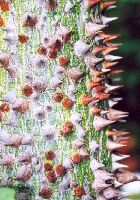 Many of the trees were new to the majority of us, including the fascinating bottle-shaped Chorisia speciosa, with spike-like protrusions on the trunk. All of the trees we saw originate in Argentina or other parts of South America and are transported at a relatively mature stage to Spain. We also saw the Erythrina crista-galli, so-called because its orange-red flowers resemble a cock's crest or comb, and Geoffroea decorticans, which has an appearance similar to mimosa and is resistant to both drought and cold spells. The palms included superb examples of Butia yatay as well as Trithrinax campestris (blue needle palm) and the blue-hued Brahea armata. Many of the trees were new to the majority of us, including the fascinating bottle-shaped Chorisia speciosa, with spike-like protrusions on the trunk. All of the trees we saw originate in Argentina or other parts of South America and are transported at a relatively mature stage to Spain. We also saw the Erythrina crista-galli, so-called because its orange-red flowers resemble a cock's crest or comb, and Geoffroea decorticans, which has an appearance similar to mimosa and is resistant to both drought and cold spells. The palms included superb examples of Butia yatay as well as Trithrinax campestris (blue needle palm) and the blue-hued Brahea armata.
We then continued on to Eusebi's nursery with its vastly impressive selection of palms, including enormous examples of Phoenix canariensis, as well as Sabal mexicana which is resistant to cold and wind, Cycas revoluta and Jubaea chilensis. The long lines of palms in oversize containers formed impressive avenues and at a certain point the wide pathway with stretches of Butia yatay on either side was reminiscent of the avenues at Luxor or Karnak.
Even more breathtaking was the third part of the visit, this time to Eusebi's private estate up on the hillside. Here we were faced with the astounding scene of 25,000 palm trees of various sizes, colours and patterns, surrounding his house, almost as far as the eye could see. Eusebi's grandfather and father were dealers in soil and it was his father who started the plantation and passed on to his son the passion for palms of every description.
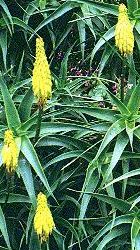 After lunch in the warm sunshine in the port of Blanes, our last visit of the day was to the Jarn Bonico Tropical Pinya de Rosa, close to Lloret de Mar. This garden has a wonderful collection of cacti and succulents and was the original idea of the owner, Dr. Fernando Riviere de Caralt, who started the collection in 1945. The timing of our excursion was carefully planned to allow us to view the aloes in flower and they were a magnificent sight. Those in bloom were mainly the Aloe arborescens species (part of the multi-stemmed aloes group), and the rambling aloe group. Amongst these we could view Aloe striatula (yellow wiry stem flowers ) and Aloe ciliaris (hair-like structure with yellow-tipped, bright red flowers ). Also in flower in the creeping aloe group were Aloe distans (head-shaped flowers from dull orange to bright red) and Aloe mitriformis (creeping aloe with bright red flowers). After lunch in the warm sunshine in the port of Blanes, our last visit of the day was to the Jarn Bonico Tropical Pinya de Rosa, close to Lloret de Mar. This garden has a wonderful collection of cacti and succulents and was the original idea of the owner, Dr. Fernando Riviere de Caralt, who started the collection in 1945. The timing of our excursion was carefully planned to allow us to view the aloes in flower and they were a magnificent sight. Those in bloom were mainly the Aloe arborescens species (part of the multi-stemmed aloes group), and the rambling aloe group. Amongst these we could view Aloe striatula (yellow wiry stem flowers ) and Aloe ciliaris (hair-like structure with yellow-tipped, bright red flowers ). Also in flower in the creeping aloe group were Aloe distans (head-shaped flowers from dull orange to bright red) and Aloe mitriformis (creeping aloe with bright red flowers).
In the spotted aloe group, we found Aloe grandidentata (multi-branched, dull red flowers), Aloe maculata and Aloe zebrina (dull pink flowers).
Sadly enough, the most spectacular aloes of the single stemmed group were not yet in bloom: Aloe marlothii (very large bright orange-red flowers), Aloe ferox (orange to red, yellowish and even white forms), Aloe speciosa (flowers changing colour from red to greenish-white rosette).
It was difficult and even impossible to distinguish all the different varieties, as most of them are natural hybrids. Hybrids often grow more rapidly, flower sooner and produce more striking flowers than pure species.
The various collections of plants in the garden have been laid out systematically in large rock-enclosed beds with strong representation from opuntias and platiopuntias, cylindropuntias and austrocylindropuntias, Agavaceae and aloes. Plants have been sourced from their natural habitats, but also from other botanical gardens and private collections all over the world. American specialists regard the Opuntia collection here as one of the most important globally, and the collections of Agavaceae, aloes, yuccas and Mesembryanthemaceae (Aizoaceae) are considered to be amongst the best in Europe. The entire collection currently contains more than 7000 species excluding the local flora. Every year more than 1500 species are sown to increase the collection, which is based on original types and officially recognised hybrids.
The Pinya de Rosa Garden is located on a hillside with a view of the sea, and it is possible to walk down to the beach through a wooded area which belongs to the property. We were fortunate to be there when there were virtually no other visitors, which gave us the impression of having this beautiful park full of exotic foliage and flowers all to ourselves.
At first glance one might think that a day spent looking at palm trees and succulents is quite a narrow choice - but no, it was fascinating and inspiring to see what is available and what one can do with plants that make a major contribution to a drought-resistant and water-wise garden.
Liz Thompson and Dominique Cordonnier
Branch Head - Joan Ball

"I inherited my passion for gardening from my mother who was a prize rose grower and my grandfather who was a successful nurseryman. During the past 30 years I have designed and planted my own gardens, with the help of my husband and assistant gardener Andy, in England, America and now in the Costa Brava, Spain. Although I have no formal gardening qualifications I have always had a desire to improve my knowledge of gardening, either through courses, lectures, garden visits or by listening to more experienced gardeners. My current garden on the Costa Brava is a terraced garden which consists of a rose garden, organic vegetable & fruit garden, Mediterranean dry garden, tropical garden and, most recently, a medicinal herbal garden which helps me in my work as a Nutritionist. We have decided to run the Catalonia Branch with a Core Group of experienced gardeners - Brian Constable, Jaume Rexach , Judy Tipple and myself – so if I cannot help you I am sure they will. We are also working in close alliance with the Mar i Murtra Botanical Gardens in Blanes, Costa Brava."
"Heredé mi pasión por la jardinería de mi madre que era un premio que cultiva rosas y mi abuelo que era un vivero con éxito. Durante los últimos 30 años he diseñado y plantado mis propios jardines, con la ayuda de mi esposo y asistente jardinero Andy, en Inglaterra, Estados Unidos y ahora en la Costa Brava, España. A pesar de que no tengo calificaciones formales jardinería siempre he tenido el deseo de mejorar mis conocimientos de jardinería, ya sea a través de cursos, conferencias, visitas de jardín o escuchar más jardineros con experiencia. Mi jardín actual de la Costa Brava es un jardín con terraza que consta de un jardín de rosas, hortalizas y frutas orgánicas, jardín mediterráneo seco, jardín tropical y, más recientemente, un jardín de plantas medicinales que me ayuda en mi trabajo como nutricionista. Hemos decidido ejecutar la Subdivisión de Cataluña con un grupo básico de los jardineros con experiencia - Brian Constable, Jaume Rexach, Judy Tipple y yo - por lo que si no puedo ayudarte estoy segura que lo harán. También estamos trabajando en estrecha alianza con los jardines de Mar i Murtra Botánico de Blanes, Costa Brava."
"Vaig heretar la meva passió per la jardineria de la meva mare que era un premi que cultiva roses i el meu avi que era un viver amb èxit. Durant els últims 30 anys he dissenyat i plantat els meus propis jardins, amb l'ajuda del meu marit i assistent jardiner Andy, a Anglaterra, Estats Units i ara a la Costa Brava, Espanya. Tot i que no tenen qualificacions formals jardineria sempre he tingut el desig de millorar els meus coneixements de jardineria, ja sigui a través de cursos, conferències, visites de jardí o escoltar més jardiners amb experiència. El meu jardí actual de la Costa Brava és un jardí amb terrassa que consta d'un jardí de roses, hortalisses i fruites orgàniques jardí, jardí mediterrani sec, jardí tropical i, més recentment, un jardí de plantes medicinals que m'ajuda en el meu treball com a nutricionista. Hem decidit executar la Subdivisió de Catalunya amb un grup bàsic dels jardiners amb experiència - Brian Constable, Jaume Rexach, Judy Tipple i jo - pel que si no puc ajudar-te estic segur que ho faran. També estem treballant en estreta aliança amb els jardins de Mar i Murtra Botànic de Blanes, Costa Brava."
|


